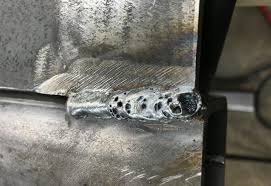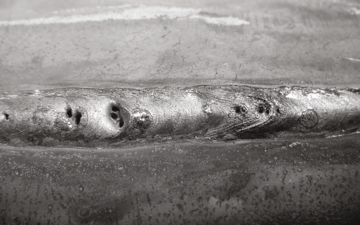Deciphering the Enigma of Porosity in Welding: Tips for Lessening Flaws and Making Best Use Of Quality
In the elaborate world of welding, porosity stays a relentless obstacle that can significantly impact the high quality and honesty of bonded joints. As we dive right into the depths of porosity in welding, discovering the tricks to its avoidance and control will certainly be vital for experts seeking to grasp the art of premium weldments.
Understanding Porosity in Welding
Porosity in welding, a common issue encountered by welders, refers to the visibility of gas pockets or gaps in the welded material, which can compromise the honesty and top quality of the weld. These gas pockets are typically caught during the welding process as a result of numerous variables such as inappropriate shielding gas, contaminated base products, or wrong welding criteria. The development of porosity can compromise the weld, making it at risk to splitting and rust, ultimately causing architectural failures.
By identifying the importance of keeping proper gas protecting, making certain the cleanliness of base materials, and enhancing welding setups, welders can significantly minimize the chance of porosity formation. Generally, a thorough understanding of porosity in welding is important for welders to produce top notch and durable welds.

Usual Sources Of Porosity
When evaluating welding processes for potential high quality concerns, understanding the typical reasons for porosity is crucial for maintaining weld stability and stopping architectural failings. Porosity, identified by the presence of cavities or gaps in the weld metal, can considerably jeopardize the mechanical buildings of a bonded joint. One usual source of porosity is inappropriate securing gas protection. Insufficient shielding gas flow prices or improper gas mixtures can lead to atmospheric contamination, causing porosity development.
Additionally, welding at inappropriate parameters, such as exceedingly high travel rates or currents, can generate too much turbulence in the weld swimming pool, capturing gases and triggering porosity. By dealing with these usual reasons through appropriate gas shielding, material preparation, and adherence to optimum welding parameters, welders can decrease porosity and improve the top quality of their welds.
Methods for Porosity Avoidance
Carrying out effective preventative measures is crucial in decreasing the occurrence of porosity in welding procedures. One technique for porosity avoidance is guaranteeing correct cleansing of the base steel before welding. Pollutants such as oil, oil, rust, and paint can cause porosity, so comprehensive cleansing making use of appropriate solvents or mechanical techniques is crucial.

Utilizing top notch filler products and protecting gases that are appropriate for the base metal and welding procedure can dramatically lower the threat of porosity. In addition, keeping correct welding criteria, such as voltage, existing, take a trip rate, and gas circulation rate, is important for porosity prevention.
Moreover, utilizing correct welding strategies, such as preserving a constant travel speed, electrode angle, and arc length, can help prevent porosity (What is Porosity). Ample training of welders to guarantee they comply with best techniques and quality control treatments is additionally vital in decreasing porosity problems in welding

Best Practices for Quality Welds
Ensuring adherence to industry standards and correct weld joint preparation are fundamental facets of accomplishing regularly premium welds. In addition to these foundational actions, there are a number of best techniques that welders can carry out to even more boost the high quality of their welds. One key technique is keeping proper sanitation in the welding location. Contaminants such as oil, oil, rust, and paint can detrimentally impact the quality of the weld, causing problems. Extensively cleaning up the workpiece and bordering area prior to welding can help alleviate these issues.
Another ideal practice is to very carefully select the proper welding criteria for the particular products being joined. This includes establishing the proper voltage, current, take a trip speed, and securing gas flow rate. Appropriate parameter choice makes certain optimum weld penetration, combination, and overall high quality. In addition, using top notch welding consumables, such as electrodes and filler steels, can significantly affect the last weld high quality. Buying premium consumables can lead to stronger, a lot more sturdy welds with fewer flaws. By adhering to these finest methods, welders can continually generate high-quality welds that meet industry standards and surpass consumer assumptions.
Importance of Porosity Control
Porosity control plays an important role in ensuring the honesty and top quality of welding joints. Porosity, characterized by the presence of cavities or voids within the weld metal, can substantially endanger the mechanical buildings and architectural stability of the weld. Excessive porosity weakens the weld, making it more susceptible to breaking, corrosion, and total failure advice under functional tons.
Effective porosity control is essential for keeping the desired mechanical properties, such visite site as stamina, ductility, and durability, of the bonded joint. What is Porosity. By lessening porosity, welders can boost the overall quality and dependability of the weld, guaranteeing that it meets the performance needs of the intended application
Additionally, porosity control is essential for achieving the wanted visual appearance of the weld. Extreme porosity not only damages the weld but additionally interferes with its visual charm, which can be crucial in sectors where aesthetics are important. Correct porosity control techniques, such as making use of the right securing gas, managing the welding parameters, and making sure appropriate cleanliness of the base products, are essential for creating high-quality welds with minimal flaws.

Final Thought
Finally, porosity in welding is an usual flaw that can compromise the quality of the weld. By comprehending the causes of porosity and executing correct avoidance methods, welders can decrease defects and achieve better welds. It is vital to manage porosity in welding to make certain the index honesty and toughness of the last product. Executing finest methods for porosity control is crucial for achieving optimum welding outcomes.